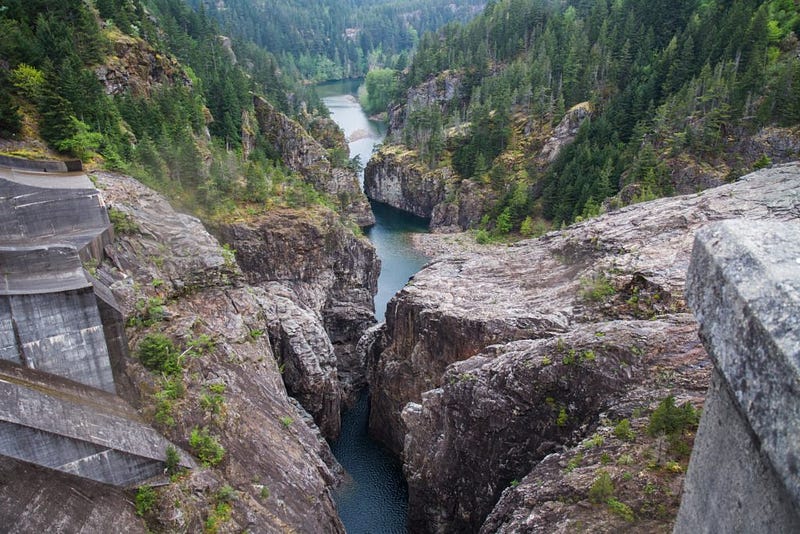River be dammed
Melting glaciers threaten the Skagit River and hydropower dams in the North Cascades
STORY AND PHOTOS BY TYLER HILLIS
(Above) The Diablo Dam is one of three Dams placed along the Skagit River as part of the Skagit Hydroelectric Project. It is 1,180 feet wide and creates the Diablo Lake behind it.
Tucked between the peaks of the North Cascades Mountain Range, a great beast lurks. The creature slithers from British Columbia to the Puget Sound, carving out valleys and cascading over cliffs.
This great snake is the Skagit River, and receding glaciers are threatening to change it.
All 47 monitored glaciers in the North Cascades, made of packed ice and snow, have been in retreat since 1984, averaging 340 meters in reduction — over three football fields in length, according to North Cascade Glacier Climate Project Director Mauri Pelto. Of those 47, five have disappeared completely. These glaciers feed the Skagit and less powerful Sauk and Baker Rivers.
Dr. Jon Riedel, geologist for the National Park Service, has been recording the reduction and disappearance of the glaciers since the 1980s. He is focused on measuring the mass balance of the glaciers to calculate the total loss in volume.
“We are anticipating a big loss this year,” Riedel says. “Last year we had our most extreme loss.”
These reductions are due to two separate effects of climate change: lower average snowfall in winter months, which leads to less snowpack each year, and higher temperatures in spring and summer, resulting in glaciers melting at a quicker rate than they are building.
“The river will get a whole lot of water in the spring, but by summer, there will be less and less glacial runoff,” Riedel says.
This is a problem Mark Mastin highlights in his data on the Sauk River. Mastin is a surface water specialist for the U.S. Geological Survey.
“Right now, we are actually seeing the same amount of volume come through these tributaries,” Mastin says. “But the time in which it is coming is changing. It is a seasonal change that leads to large amounts of water during the winter months, when we don’t really need it, and low amounts of water when we really need it in the summer.”

The Department of Ecology for Washington State dubbed 2015 “the year of the snowpack drought.” While Washington had normal levels of precipitation throughout winter, temperatures were warmer, meaning precipitation fell as rain and not snow. During the summer, the snowpack shortage produced record low river flows, threatening the three dams built along the river, known as the Skagit River Hydroelectric Project.
Washington generates 70 percent of its power with hydropower dams, compared to the national average of 7 percent. Seattle City Light maintains the three dams and generates up to 89.6 percent of its electricity through hydropower.
Crystal Raymond (PhD) is the Climate Change Strategic Advisor for Seattle City Light tasked with adapting the electric utilities of the Hydroelectric Project to the river’s changes. She is leading an initiative to assess and propose changes based on the project’s expected problems.
Raymond is currently engaged in the first stage of the initiative, which involves taking data and producing models to show the changes ahead. In collaboration with a research team, she focused on identifying the altered stream flow timing, changes in extreme weather and the rising sea levels. They will also look at consequences on energy demand and delivery, stream temperature and endangered fish species.
“With those varying times when the runoff comes down, we are generating energy at different times,” Raymond says. “Just like water droughts, there can be an energy drought in the summer when more people are using electricity.”
Changes in river flow have altered how and when water is stored in reservoirs, Mastin says.

“[Water managers] are still trying to maximize water for storage,” Mastin says. “We have to find a balance of keeping enough water for the summer months without increasing the risk of floods in the winter.”
In preparing for low snowmelt in the summer, many reservoir managers may need to increase how much they collect in the winter, Mastin says. However, if the reservoir is at capacity and a surge of water comes, the reservoir cannot safely contain a flood. Increased flooding can lead to sediment buildup and decreasing water quality, according to the U.S. Global Change Research Program.
As the Skagit flows through the dams and beyond, the beast will continue to affect those along its banks. The serpent, so elegant and robust in the resources it provides, will not become extinct; it will evolve, finding new ways to trickle and flow down the valleys it carves. Just as the great snake adapts, so must we.
